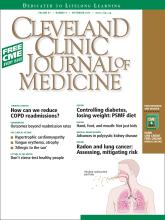Table of Contents
From the Editor
- Polycystic kidney disease: Molecular understanding dictating management
It was the early 1980s, I was a resident in the emergency room, and the patient had fever, flank pain, hypotension, and a normal urinalysis.
The Clinical Picture
- Hypertrophic cardiomyopathy apical variant
When a professional soccer player required ankle surgery, his electrocardiogram showed several abnormalities.
- ‘Allergic to the sun’
A homeless man presents with burning pain and lesions in his arm for the past 2 to 3 days.
- Erythema and atrophy on the tongue
Oral abnormalities can result from nutritional deficiencies and a host of other conditions.
1-Minute Consult
- Can we reduce the risk of readmission for a patient with an exacerbation of COPD?
The risk can be reduced by using a checklist before discharge and by implementing outpatient programs that continue patient education and provide rapid access to medical support if needed.
Review
- Hand, foot, and mouth disease: Identifying and managing an acute viral syndrome
This is typically a benign childhood infection—except when it isn’t so benign or when it occurs in an adult.
- The protein-sparing modified fast for obese patients with type 2 diabetes: What to expect
Committed patients can lose weight and control their diabetes, but they need encouragement and close supervision.
- Radon and lung cancer: Assessing and mitigating the risk
Radon exposure is the second most common cause of lung cancer, but the evidence so far does not support screening for lung cancer in people exposed to it.
Medical Grand Rounds
- Advances in autosomal dominant polycystic kidney disease—2014 and beyond
An overview of its pathogenesis, diagnosis, management, complications, and future possible treatment.
Departments
- Stress testing (July 2014)
A reader comments on stress testing in asymptomatic patients at low risk (July 2014).
- In Reply: Stress testing (July 2014)
A reader comments on stress testing in asymptomatic patients at low risk (July 2014).





Commentary
Focusing on the readmission rate diverts attention from more proactive ways to improve safety, quality, and value.